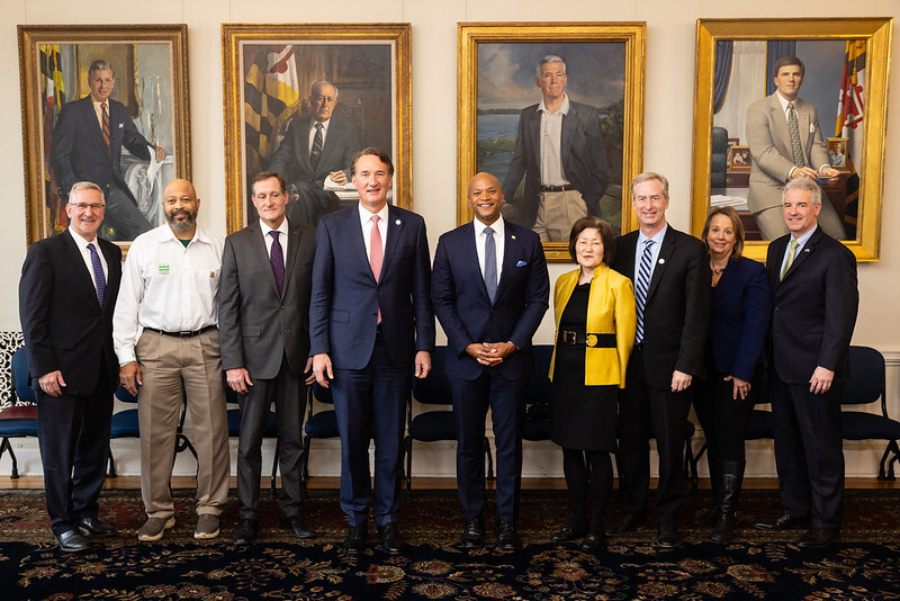Chesapeake Executive Council
The Chesapeake Executive Council establishes the vision and strategic direction for the restoration and protection of the Chesapeake Bay. It consists of the governors of the six watershed states, the mayor of Washington, D.C., the chair of the Chesapeake Bay Commission and the administrator of the U.S. Environmental Protection Agency.
Meetings
No upcoming meetings.
2025 Chesapeake Executive Council Meeting
2024 Chesapeake Executive Council Meeting
2023 Chesapeake Executive Council Meeting
About
The Chesapeake Executive Council was established by the Chesapeake Bay Agreement of 1983. Under the 1987 Chesapeake Bay Agreement, membership changed from cabinet secretaries to the governors of Maryland, Pennsylvania and Virginia; the administrator of the U.S. Environmental Protection Agency; the mayor of the District of Columbia; and the chair of the Chesapeake Bay Commission. The Chesapeake 2000 agreement marked the official inclusion of the Bay’s headwater states (Delaware, New York and West Virginia) in the Bay Program’s restoration efforts. The governors of New York and Delaware committed to the agreement's water quality goals through a memorandum of understanding signed in 2000. The governor of West Virginia added his signature in 2002.

The Executive Council:
- Establishes the policy direction for the restoration and protection of the Bay and its living resources.
- Provides leadership to promote public support for Bay restoration and protection.
- Is accountable to the public for progress made under Bay agreements.
The Executive Council meets at least annually.
Publications
Directive No. 24-1: Establishment of a Chesapeake Bay Program Agricultural Advisory Committee
Publication date:This directive establishes a new advisory committee to facilitate greater engagement of the agricultural sector in the Chesapeake Bay Program.
Charge to the Principals' Staff Committee: Charting a Course Beyond 2025
Publication date:This charge directs the Principals' Staff Committee to revise the 2014 Chesapeake Bay Watershed Agreement and recommend a simplified and streamlined structure and process for the Chesapeake Bay Program partnership.
Charge to the Principals' Staff Committee: Charting a Course to 2025 and Beyond
Publication date:This charge directs the Principals' Staff Committee to recommend a path for meeting the goals and outcomes of the 2014 Chesapeake Bay Watershed Agreement leading up to and beyond 2025.
Statement in Support of Diversity, Equity, Inclusion and Justice
Publication date:This statement affirms the Chesapeake Bay Program's commitment to embrace diversity, equity, inclusion and justice.
View document [PDF, 444.3 KB] Statement in Support of Diversity, Equity, Inclusion and Justice
Resolution in Support of the Chesapeake Bay Program Partnership
Publication date:This resolution calls upon the President and United States Congress to continue federal support for the Chesapeake Bay Program.
View document [PDF, 635.5 KB] Resolution in Support of the Chesapeake Bay Program Partnership
Our Members
- Wes Moore (Chair)
State of Maryland moore.wes@maryland.gov - Rachel Felver (Coordinator)
Alliance for the Chesapeake Bay rfelver@chesapeakebay.net - Bianca Martinez Penn (Staffer)
Chesapeake Research Consortium bmartinezpenn@chesapeakebay.net - Muriel Bowser
District of Columbia eom@dc.gov - Kathy Hochul
State of New York gov.hochul@chamber.state.ny.us - Sara N. Love
Chesapeake Bay Commission sara.love@senate.state.md.us - Matt Meyer
State of Delaware matt.meyer@delaware.gov - Patrick James Morrisey
State of West Virginia patrick.morrisey@wv.gov - Josh Shapiro
Commonwealth of Pennsylvania governor@pa.gov - Glenn Youngkin
Commonwealth of Virginia glenn.youngkin@governor.virginia.gov - Lee Zeldin
U.S. Environmental Protection Agency (EPA) zeldin.lee@epa.gov
